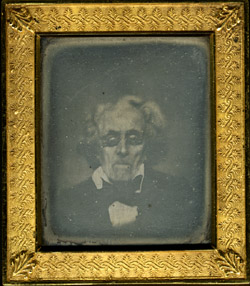 In the late summer, 1839, Louis Jacques Mandé Daguerre bestowed the gift of photography upon the world. Although the origins of photography remain murky and the subject of much debate, there is little doubt that Daguerre's English-language publication, An Historical Account and a Descriptive Account of the Various Processes of the Daguerreotype and the Diorama sparked enormous interest among Americans and induced many to explore the arcana of photographic chemistry. It was hailed as truly one of the technological marvels of the age.
In the late summer, 1839, Louis Jacques Mandé Daguerre bestowed the gift of photography upon the world. Although the origins of photography remain murky and the subject of much debate, there is little doubt that Daguerre's English-language publication, An Historical Account and a Descriptive Account of the Various Processes of the Daguerreotype and the Diorama sparked enormous interest among Americans and induced many to explore the arcana of photographic chemistry. It was hailed as truly one of the technological marvels of the age.
News of Daguerre's publication arrived in the United States in late August or early September, 1839, and several Philadelphians set out immediately to replicate Daguerre's process. One of the oldest surviving images from North America is a view of Central High School in Philadelphia, taken by Joseph Saxton on September 25, 1839, and a handful of others are known to have been taken later that year. In October, a young manufacturer of lamps, Robert Cornelius, worked with Saxton to learn the basics of the daguerreian process and soon began to .
 As ingenious as he was fearless, Cornelius brought with him a strong practical knowledge of metallurgy and chemistry. Although some scientists had felt that the exposure times needed to make successful photographs were too long for portraiture, in November or December, Cornelius proved them wrong by making himself the subject of what may have been his first successful photograph - a self-portrait taken outside of his place of business on 8th Street between Market and Chestnut (three blocks from the APS). Regardless of whether this image truly was his first successful image, the portrait remains one of the world's oldest photographic portraits.
As ingenious as he was fearless, Cornelius brought with him a strong practical knowledge of metallurgy and chemistry. Although some scientists had felt that the exposure times needed to make successful photographs were too long for portraiture, in November or December, Cornelius proved them wrong by making himself the subject of what may have been his first successful photograph - a self-portrait taken outside of his place of business on 8th Street between Market and Chestnut (three blocks from the APS). Regardless of whether this image truly was his first successful image, the portrait remains one of the world's oldest photographic portraits.
 Over the course of the next two months, Cornelius experimented with photographic chemistry in search of a reagent to accelerate the process, working in conert with a young chemist from the University of Pennsylvania, Paul Beck Goddard. By December, the two had begun to employ bromine as a reagent, and the success of their efforts can be gauged by a handful of surviving photographic images and by the fact that in the Spring, 1840, Cornelius was able to open a commercial photographic studio -- the second such studio in America. Among the earliest of Cornelius' extant portraits is the now-faded image of Goddard (above left) in his wire-rimmed glasses, taken in December, 1839.
Over the course of the next two months, Cornelius experimented with photographic chemistry in search of a reagent to accelerate the process, working in conert with a young chemist from the University of Pennsylvania, Paul Beck Goddard. By December, the two had begun to employ bromine as a reagent, and the success of their efforts can be gauged by a handful of surviving photographic images and by the fact that in the Spring, 1840, Cornelius was able to open a commercial photographic studio -- the second such studio in America. Among the earliest of Cornelius' extant portraits is the now-faded image of Goddard (above left) in his wire-rimmed glasses, taken in December, 1839.
Almost as old as the image of Goddard is the portrait of the superannuated stalwart of the APS, Peter Stephen Duponceau (above right), which was presented to the Society in March, 1840. Then nearly 80 years old, Duponceau was renowned as a brilliant interpreter of international law and an equally brilliant historian and philologist. It was his interest in Native American languages, as much as Jefferson's, that led to the development of the massive linguistic collections at the APS.
Both Goddard and Cornelius were elected to the APS, Goddard in 1840, Cornelius not elected until 1862.
